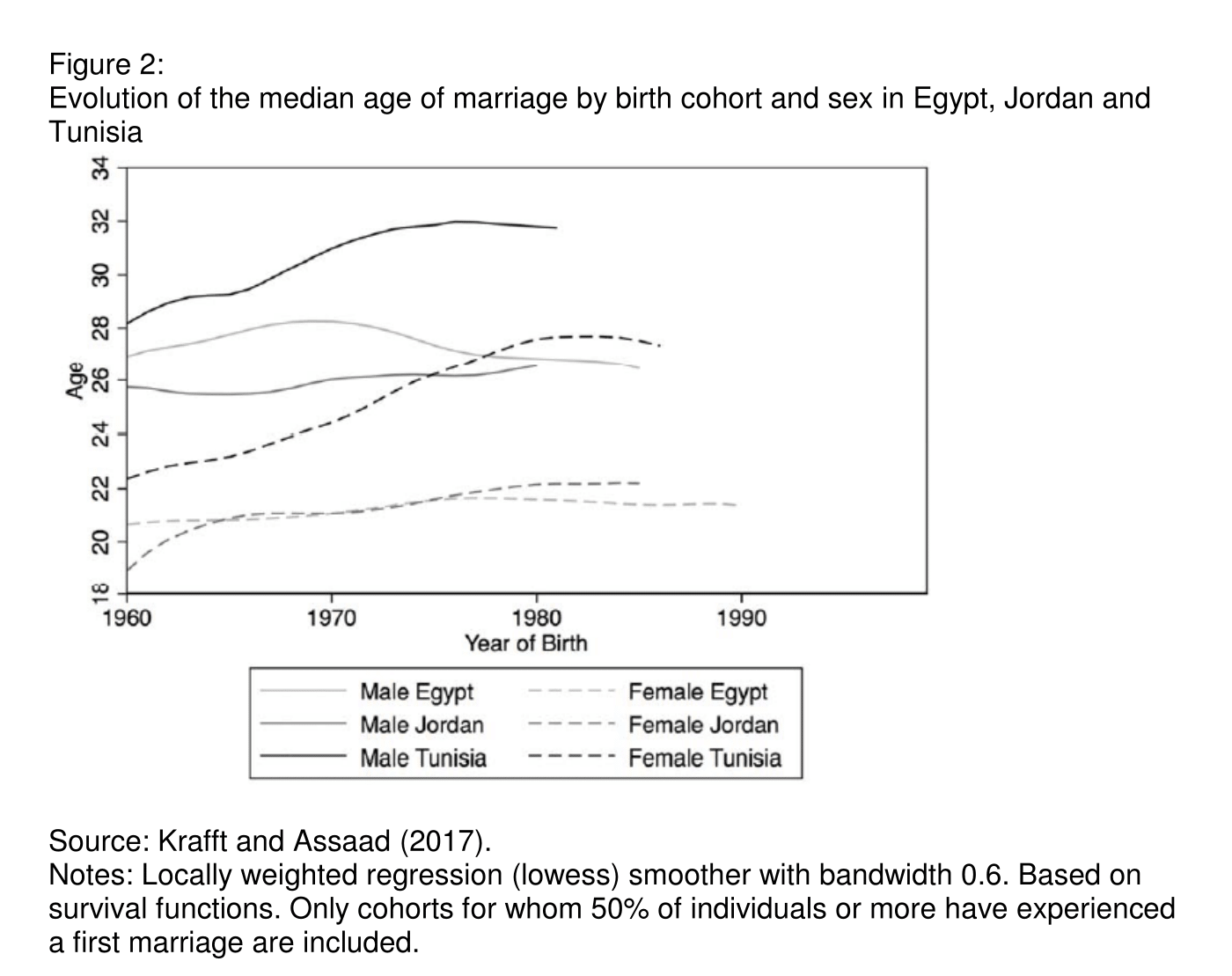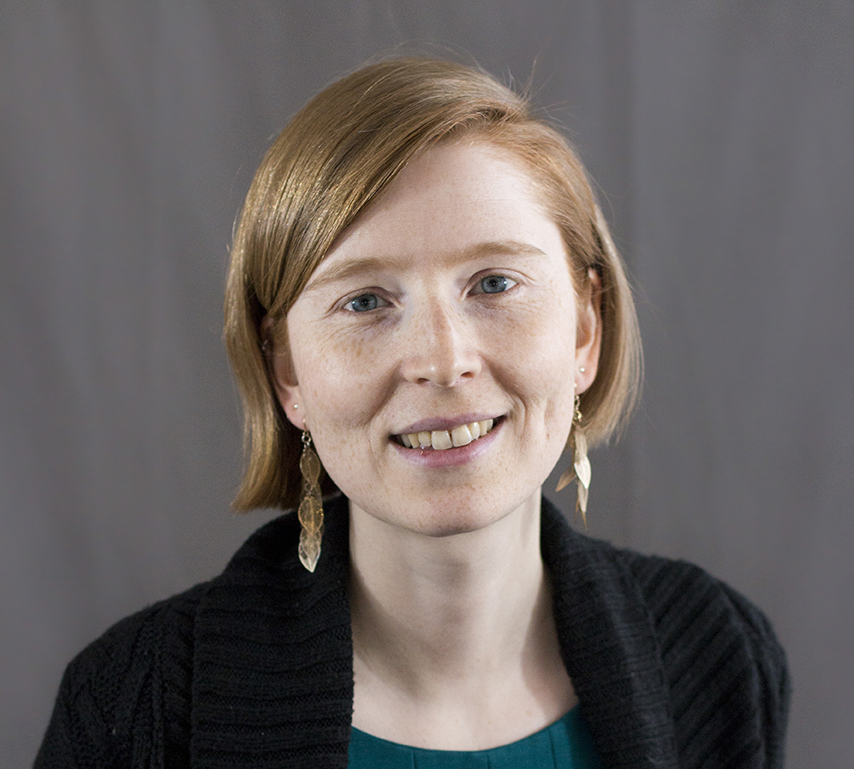In a nutshell
Young people in MENA countries struggle to signal their economic readiness for marriage and, in particular, to obtain housing.
Rental housing offers a speedier alternative to homeownership, but rental units are not necessarily available or affordable.
The effect of Egypt’s ‘new rent’ law on young people’s age at marriage shows how policy reforms in housing markets can facilitate their transition to adulthood.
Marriage is a fundamental step into adulthood in the countries of the Middle East and North Africa (MENA). Readiness for marriage requires securing substantial resources (Salem, 2014, 2015; Singerman, 2007). Struggles to do that have led to frustrating delays, part of the regional challenge of waiting for adulthood or ‘waithood’ (Dhillon and Yousef, 2009).
The expectation of independent living
One factor contributing to waithood is that young people increasingly expect to live independently after marriage. Among couples in Egypt, Jordan and Tunisia who were married in the latter half of the 2000s and the early 2010s, roughly four out of five adopted an independent, nuclear living arrangement at marriage. This is a higher rate than in previous generations (Assaad et al, 2017a; Salem, 2014, 2015).
The groom and his family are primarily responsible for securing housing (Dhillon et al, 2009). Housing is the largest component of marriage costs and the greatest challenge to secure in a number of MENA countries. For example, 71% of young people in Egypt identify the cost of housing as the main obstacle to marriage (Gebel and Heyne, 2014).
Housing requires the accumulation of large sums of money upfront and the difficulties of accumulating such resources delay marriage. For example, initial housing costs for Egyptian grooms consume around two full years of wages, and these costs were 28% of the marriage budget in 2012 (see Figure 1). Jordanians face a lower cost of housing at marriage: around half a year’s wages and only 9% of the marriage budget in 2010.
Less expensive housing may be one of the reasons why Jordanians have not experienced the same rising ages of marriage observed in other countries in the region (see Figure 2). In Jordan, the median age of marriage for men remained stable at around 26 for the cohorts born between 1960 and 1980. The median age for women in Jordan increased a little, but then levelled off at around 21.
In contrast, the median age at marriage for both men and women in Tunisia increased over time: from around 28 for men born in 1960 to 32 for those born in 1980. For men in Egypt, the median age at marriage was rising towards 28 for those born prior to 1972, but this trend then reversed with falling ages at marriage.
Implications of housing policy for the timing of marriage
So why did the marriage age for Egyptian men start to decline for those born from around 1972? Our research attributes this reversal to a reform in housing policy (Assaad et al, 2017b).
The ‘new rent’ law, which was passed in 1996, allowed for definite duration rental contracts and for landlords to change the rent at the end of the contract period (Assaad and Ramadan, 2008). This created efficiencies in the housing market and made it easier to acquire market-rate rental housing.
Figure 2 shows the trend of rising age at marriage among Egyptian young men reversing for those born around 1972. These men would have been approaching marriageable age – around 24 – in 1996 when the law was passed.
How can we be sure that the rental reform caused earlier marriages in Egypt? Our formal test of the effect of the law on the timing of marriage uses ‘difference-in-difference’ analysis (Assaad et al, 2017b). We compare men born in 1971 and earlier (who were not affected by the law) with those born in 1972 and later (who were affected by the law) by how prevalent rental and ‘new rent’ units were in their birthplace.
The introduction of the ‘new rent’ law accelerated marriage for young men born in 1972 and later. Men from areas with more rentals and more new rentals who were born from 1972 had a higher chance of marrying.
Specifically, a one standard deviation increase in the share of ‘new rent’ units in rentals raised the annual chance of marrying for men born starting in 1972 by 14%. A one standard deviation increase in the share of rental units in all housing also increased the annual chance of marrying for men born in 1972 or later by about 10%.
How does housing policy relate to marriage in other countries? Although we do not have policy reforms that we can study in Jordan or Tunisia, the patterns of housing policy and age at marriage suggest important links.
Ineffective housing policy in Tunisia may be related to the rising age at first marriage. Tunisia removed rent controls in the 1970s, but continues to have relatively low rates of rental due to strong tenancy rights, which make eviction difficult (Hammam, 2014). Although there are limited data on housing affordability in Tunisia, research suggests that the ratios of housing costs to income are fairly high (Beidas-Strom et al, 2009).
Among Egypt, Jordan and Tunisia, it is Jordan that has the most flexible housing market. Jordan has a relatively high proportion of rentals in the tenure mix, relatively low ratios of initial housing costs to income, and low shares of initial housing costs in the total costs of marriage (Assaad et al, 2017b). Jordan is also the country with the lowest age at marriage.
What we can learn from the ‘new rent’ law
Young people in MENA countries struggle to signal their economic readiness for marriage and, in particular, to obtain housing. Rental housing may offer a speedier alternative to homeownership since it is an option that does not require as much money upfront. But rental units are not necessarily available or affordable, particularly in Tunisia and in Egypt prior to the passage of the ‘new rent’ law.
The effect of Egypt’s ‘new rent’ law on the timing of marriage shows how policy reforms in housing markets can facilitate the transition to marriage. If other countries improve their rental markets, such reforms may help young people to make more rapid and successful transitions to adulthood.
Further reading
Assaad, Ragui, Samir Ghazouani and Caroline Krafft (2017a) ‘Marriage, Fertility, and Women’s Agency in Tunisia’, ERF Working Paper.
Assaad, Ragui, Caroline Krafft and Dominique Rolando (2017b) ‘The Role of Housing Markets in the Timing of Marriage in Egypt, Jordan, and Tunisia’, ERF Working Paper No. 1081.
Assaad, Ragui, and Mohamed Ramadan (2008) ‘Did Housing Policy Reforms Curb the Delay in Marriage Among Young Men in Egypt?’, Middle East Youth Initiative Policy Outlook No. 1.
Beidas-Strom, Samya, Weicheng Lian and Ashwaq Maseeh (2009) ‘The Housing Cycle in Emerging Middle Eastern Economies and Its Macroeconomic Policy Implications’, IMF Working Paper No. 09/288.
Dhillon, Navtej, Paul Dyer and Tarik Yousef (2009) ‘Generation in Waiting: An Overview of School to Work and Family Formation Transitions’, in Generation in Waiting: The Unfulfilled Promise of Young People in the Middle East, Brookings Institution Press.
Dhillon, Navtej, and Tarik Yousef (2009) Generation in Waiting: The Unfulfilled Promise of Young People in the Middle East, Brookings Institution Press.
Gebel, Michael, and Stefanie Heyne (2014) Transitions to Adulthood in the Middle East and North Africa: Young Women’s Rising? Palgrave Macmillan.
Hammam, Sonia (2014) ‘Housing Matters’, World Bank Policy Research Working Paper No. 6876.
Krafft, Caroline, and Ragui Assaad (2017) ‘Employment’s Role in Enabling and Constraining Marriage in the Middle East and North Africa’, ERF Working Paper No. 1080.
Salem, Rania (2014) ‘Trends and Differentials in Jordanian Marriage Behavior: Timing, Spousal Characteristics, Household Structure and Matrimonial Expenditures’, in The Jordanian Labour Market in the New Millennium, edited by Ragui Assaad, Oxford University Press.
Salem, Rania (2015) ‘Changes in the Institution of Marriage in Egypt from 1998 to 2012’, in The Egyptian Labor Market in an Era of Revolution edited by Ragui Assaad and Caroline Krafft, Oxford University Press.
Singerman, Diane (2007) ‘The Economic Imperatives of Marriage: Emerging Practices and Identities Among Youth in the Middle East.’ Middle East Youth Initiative Working Paper No. 6.
Initial housing costs in terms of years of grooms’ wages and as a percentage of total marriage costs in Egypt (2006, 2012) and Jordan (2010).





